Posted by Benjamin Hunting Know How
A seized lug nut can turn the simple task of changing a tire into a frustrating experience. It doesn’t have to be that way — there are a number of tricks on how to loosen a nut that just won’t budge, so you can get the job done and get back on the road. Let’s look at the basic steps you should go through when dealing with a stuck lug nut.
1. Soak ItMost of the time, a seized lug nut won’t lighten its grip due to corrosion, which happens when water, road salt and oxygen mix where the threads meet. It can also occur at the base of the nut, cementing it in place.
The least labor-intensive way to break a rusty lug nut free is by soaking it in a product like WD-40, PB Blaster or some other oil-based lubricant. Spray it at the base of the nut and wait, as long as you can, for the oil to work its way through the threads and between the nut and the metal of your hub. If you can, try leaving it overnight.
If your socket isn’t tight enough, it won’t be able to properly grip and turn the seized lug nut. In fact, a loose socket is more likely to spin around the nut and round off its edges, creating a second problem for you to deal with. Ensure that the socket you are using is the right size, and that it’s on as tight as possible before applying torque.
3. Mechanical AdvantageYou can increase the amount of torque by lengthening the arm of the driver used to spin the socket. Use as long of a driver handle as you can, and then fit a piece of hollow piping over the handle to further extend the arc. This can add two to three times as much torque to that initial turning action, which is often what is needed to break the lug nut loose. You can also hammer it, or jump down on the bar (as long as it’s tightly secured), to add extra turning force.
Avoid Power ToolsWhile it might be tempting to use an impact wrench to remove a seized lug nut, it’s not the best idea. More often than not, an impact driver will simply round off the nut rather than break it free if it’s really stuck. The above steps — combined with patience and time — are the best options for easy lug nut removal.
More often than not, an impact driver will simply round off the nut rather than break it free if it’s really stuck. The above steps — combined with patience and time — are the best options for easy lug nut removal.
Check out all the tire and wheel products available on NAPA Online or trust one of our 17,000 NAPA AutoCare locations for routine maintenance and repairs. For more information on dealing with a seized lug nut, chat with a knowledgeable expert at your local NAPA AUTO PARTS store.
Photo courtesy of Creative Commons.
Categories
Know How
Tags
hardware, lug nut, lug nut remover, nut, removing rusted nuts and bolts, rust, wheel stud, wheels
Having been bitten by the car bug at a young age, I spent my formative years surrounded by Studebakers at car shows across Quebec and the northeastern United States. Over ten years of racing, restoring, and obsessing over automobiles lead me to balance science writing and automotive journalism full time. I currently contribute as an editor to several online and print automotive publications, and I also write and consult for the pharmaceutical and medical device industry.
I currently contribute as an editor to several online and print automotive publications, and I also write and consult for the pharmaceutical and medical device industry.
Asked
Modified 6 years, 1 month ago
Viewed 572k times
How do I loosen car tire lug nuts (so that I can change a tire) when they are really really stuck?
I have tried turning the provided wrench, even standing and jumping on it. This worked for 4 of the lug nuts, but not the bottom-most one.
I have heard of using a rust remover/blaster, but I do not see much rust at all, and the tires are not too old if I recall correctly.
Another recommendation I see is to use a long pipe on the handle of the wrench for more torque. But even with just the wrench I seem to be warping the stock wrench with my efforts!
But even with just the wrench I seem to be warping the stock wrench with my efforts!
Some forums recommend using a 4-way lug wrench, but they do not say how to use one, or why they are better than the stock wrench. Can they provide me more torque than jumping on a standard wrench?
Finally, I am hopeful for an answer other than take it to a shop. I know I can do that, but I am trying to avoid the expense of a tow.
3
Remember that lug nuts are exposed to literally every element that could possibly cause corrosion. It sounds like your last nut is stuck due to some rust or oxidation that you can't see. Here's how I generally approach a badly stuck nut:
Check your safety gear: eye protection, jack stands, everything to keep yourself from getting killed when this wheel finally comes loose.
Get out the penetrating oil (AKA rust blaster). Really soak the bolt and nut. Now walk away and let it soak in, possibly for hours.
Affix the correct socket to your breaker bar. This is a totally different beast from the stock tire iron. Its handle is much more durable and is very unlikely to bend under the torque that you're about to apply. Remember, think carefully about what's going to happen when the nut lets go. If you're pulling, it's not hard to end up punching yourself in the face. If you're pushing, don't let your fingers bash into the garage floor or other components. I've hurt myself using both methods when battling bolts (never worse than giving my wife an excuse to eyeroll me, thankfully).
Try getting the nut off.
Didn't work? Take a longish piece of steel pipe, stick it over the end of the breaker bar to increase the moment arm of the lever and try again.
Once I get to this point, I usually cycle between penetrating oil and a super long breaker bar. Things eventually come loose after a sufficiently long period of HULK SMASH time.
Things eventually come loose after a sufficiently long period of HULK SMASH time.
NOTE: when working with exhaust nuts and bolts, the bolt will eventually snap under enough torque. This is less likely with the much more robust wheel studs.
12
There are a number of things you can do to unstick the nut before turning it:
a lubricant or rust blaster. Keep things wet and give it time to work.
heat cycling. Heat it up (gently) and let it cool. Repeat. If you oil it up and point a propane torch at it, you may start a fire, so be careful. It's not so important to heat just the nut or just the stud - the cycles will do a lot of good.
vibrations and shocks. Rap the nut with a wrench. You don't have to hit hard; hitting over and over works. This can break the corrosion as well as help the lube work its way in.
There are several tools designed to make good use of shocks.
A handheld impact driver ($30) is a simple tool for around for just this purpose. You attach a socket, put it on the lug nut, twist, and hit with a hammer. Repeat. You could do this once a minute while the lube works its way in, and apply heat in between.
There are battery-powered impact drivers under $100 that I use for carpentry that can also do this job. If you already have a cordless drill, you can get an impact driver that uses the same battery. Loud!
Finally, you can do what the pros do - use a pneumatic impact wrench. You may be able to rent one for a single use.
Impact tools should be used with special impact-rated sockets. These use tougher steel and no chrome, so they are less likely to shatter. Eye protection is still a good idea.
Whenever I change a tire, I first break each lug nut while the car is still on the ground, with parking brake set, so everything is stable.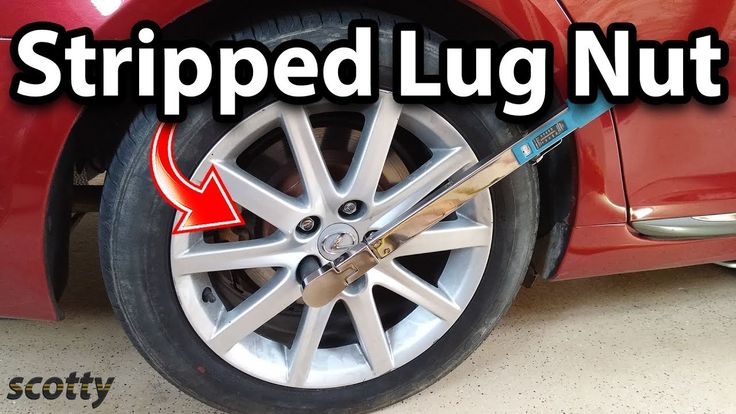
When a stud is in really bad shape, even after you break things lose, you may have to fight the rest of the way off the stud. It's a lot like cutting new threads. In that case, back off after every 1/4 turn or so, and keep adding lots of lube.
If you're trying to use the stock wrench, go out and buy a proper one! I've never seen a stock one that is any use, and some of them are so bad they may as well be made of chocolate...
A 4-way wrench is simply a cross-shaped bar with 4 different sizes of socket on the ends. You use the appropriate size one for your nuts, and then have effectively a t-bar, which means you can use both hands to get more leverage.
My preference, however, is for a telescopic bar wrench. These typically extend from around a foot to 2', and come with a selection of sockets for different sized nuts. Again, they simply allow you to get more leverage than the stock wrench, but are easier to store than a 4-way one, and by using the shorter length to re-tighten the nuts, avoids over-tightening (although as the comment above suggests, you should really use a torque wrench to tighten them correctly).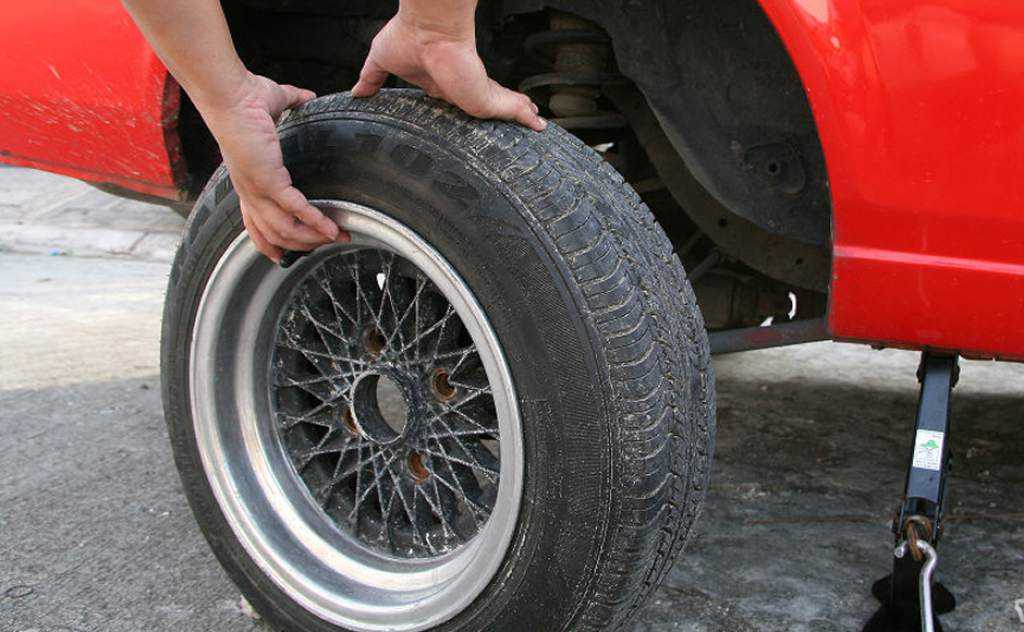
Another tip is to make sure your tyre supplier uses a torque wrench when they fit your tyres - many will use an air-gun which results in the nuts being done up excessivley tight (most likely the cause of your current problem).
2
Learn from my mistake!! I attempted to use four different chisels to 'counter rotate' the stuck nut. NEVER do this. What happens is that the chisel force drives the annular ring of the lower portion of the nut into the well where the curved face normally sits. You get the rest of the nut finaly chisseled off and you are STUCK with the measley shxxty annular ring driven and wedged into the small well. Then you have to drill and drill with, like a 5/32 drill, a whole bunch of holes and finally drive out pieces. You can drive it around the block with all nuts very loose and this shxxty annular ring is wedged way in there. Try all the other methods, heat it up, smaller socket driven on and turned, welded 2nd nut to bad nut and removing them together, whatever, BUT don't get out your chissels!!!!! You will blow nearly a day using the chisel method and have to buy a new stud and perhaps a rim as well !!!
As Bob Cross mentioned, use the breaker bar.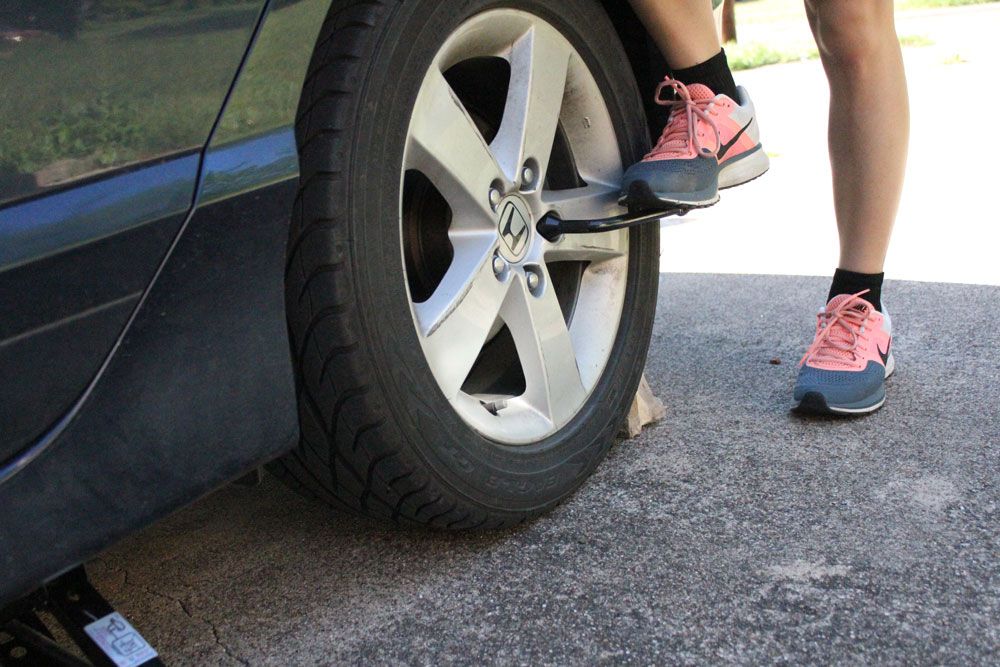 I've had to use them to remove brake calipers in the past. In the past, I have not seen such a thing as a breaker bar readily for sale at the hardware stores where I live.
I've had to use them to remove brake calipers in the past. In the past, I have not seen such a thing as a breaker bar readily for sale at the hardware stores where I live.
I have improvised a breaker bar using one of those metal pipes that are used for running electrical wires. Simply take your ratchet to the hardware store with you and find a suitably sized pipe that fits nicely around the ratchet handle.
2
All of the answers work.
But what works best for me (esp. on the side of the road!) is a 4 way tire wrench in conjunction with the screw type jack found on all cars.
Place the correct size socket on the wheel lug (nut). Position it as close to horizontal as possible. At the other end of the 4 way tire wrench, place your screw type jack and raise the height so that it supports the 4 way tire wrench in a horizontal position.
You now have a stable platform. The two free arms of the 4 way tire wrench are available for work.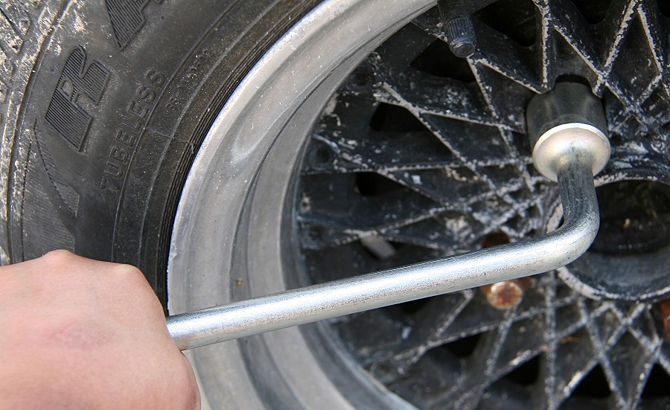
Place your foot on the free arm that will turn the lug/wrench counter clockwise. With one hand on the car for balance, stand on the free arm, as close to the end as possible, with all your weight, and "kick" down if needed.
I like this method b/c you don't have to worry about stripping the edges of the lug/nut, and ruining it.
2
One. Dont jump on it. You risk stripping the lug and stud then you can't remove the tire and Have to replace the stud.
Two. Never supposed to use grease, silicon, or wd40 on tire lugs or studs. The stud remains lubricated and the lug can work itself loose when driving after having the tire changed.
You just need to not overtighten them in the first place. Some shops do this. And have a good tire iron with leverage. Apply firm gradual torque, not sudden aggressive torque like jumping on it or hitting with a hammer. These things can cause more harm than good and people that read this and follow this advice will be stranded on the side of some highway after stripping the lug or stud. my $.02
my $.02
Turning the tire so that the stuck/frozen nut was at the top (12 o'clock) did it for me. Another try with a pipe extender on the tire wrench and the nut "cracked" and loosened. This is actually the easiest and should be the FIRST alternative in any of the answers above. I had already put nut loosener fluid on the stud and almost "rounded" out the corners of the lug nut with forcing the wrench, which could have made it impossible to remove except by an expensive garage repair.
1
Last resort... Heat the nut, and it will expand. This might help loosen it, but try this only after you have sprayed it to deaf with corrosion removing stuff. If you can see the other side, cool the lug and it will help the process. Again, last resort.
3
I just had this problem. I got all of them loose but one at the bottom. I tried everything it wouldnt come loose. Jacked it up took it out of gear spun the tire around so that the nut was on top. It came right off without a problem.
I tried everything it wouldnt come loose. Jacked it up took it out of gear spun the tire around so that the nut was on top. It came right off without a problem.
Heating the stud up with an acetylene torch worked great for me. Worked for days and days with breaker bars up to 8 feet long and nothing worked. Even broke 3 heavy duty 1/2" drive impact sockets. Took me a few try's to remove the nuts with the torch and then the tire iron but the heat definitely works. I wouldn't try unless it's a last resort.
A large T-bar may be the answer. I've found that if you tilt the thing at about a 45-degree angle, get a foot on the lower end and a hand on the upper, you can use your body weight to put tremendous torque on the nut without seriously misaligning the socket/nut.
I put a pipe on the handle of the standard wrench and jumped on it. I thought I was turning the nut, but I snapped the wrench (1/2 inch diam handle). Then I tried better wrenches, without success. I put the other nuts back on gently and drove about 4 miles.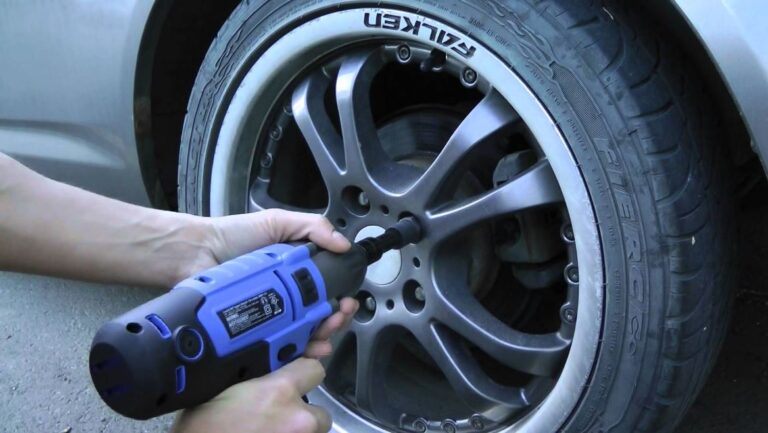 That did it. But if you have a flat tire its not a solution! Maybe if you drove 30 feet on the flat that would loosen the nut without harming the tire.
That did it. But if you have a flat tire its not a solution! Maybe if you drove 30 feet on the flat that would loosen the nut without harming the tire.
I had some stubborn nuts on my Range Rover. I always have trouble. Some nuts won't accept the the socket on the wrench as they have become deformed over time. I now use a ring spanner.
In frustration I tried using my jack. I place the ring spanner over the nut and used the jack to loosen the nuts enough to turn by hand. But this has failed to work on one nut. The pressures involved made me very nervous, so I backed off and have come on here for other ideas.
1
If you didn't take the other four off in the right order, it might help to put them back on and tighten them, then try busting the stuck one loose. Then crack them all loose in the right order. For five nuts, the right order is like you're drawing a star: go around and hit every other nut.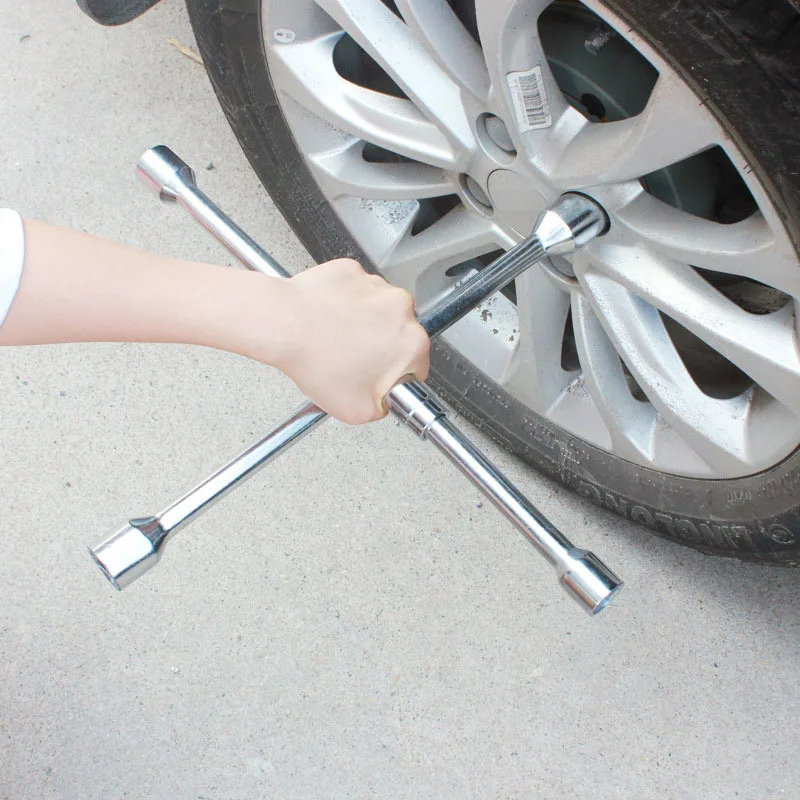 After each one just starts to turn, then go back and loosen them more.
After each one just starts to turn, then go back and loosen them more.
What can happen is if the wheel isn't heels on evenly, it can start tilting a little and this could put uneven forces on the last nut that could make it harder to remove.
In addition to going in the right order, use a 4 way tire iron and plenty of torque. See other answers.
Had a slow puncture so pumped up the tyre with my electric pump then drove to the garage to get it repaired but forgot to take my torque wrench with me. Got the fitter to use a T bar and 21mm socket to tighten the nuts then drove home to set the nuts to the recommended 80 lbs ft only to find out the first one I tried wouldn't move even with standing on a long T bar. Finally resulted in winding up my 21" long torque wrench in increments until it was at 185lbs ft and standing on it, before the nut slowly moved without the torque wrench breaking. Luckily the max setting is 220lbs ft as I was getting concerned that it was going to be back to the garage.
1
Let's talk about the use of studs on car tires - what they are made of. The design of studs for winter tires of the car and their number. How studded tires are rolled.
are for The spikes consist of two parts: a body and a carbide insert. The task of the body is to keep the stud in the tread body during the entire life of the tire. And the pin (carbide insert) should bite into the road surface, increasing the coefficient of adhesion on slippery surfaces. nine0003
For the manufacture of inserts, tungsten carbide and a number of other compounds are used. Each manufacturer has its own proprietary carbide recipe. Some additives are known to reach hardness of 1500 Vickers units. To work on ice or snow, such strength is not needed, but on asphalt, the insert wears out at the same rate as the tire tread.
At the end of winter, ruts remain on the pavement, studded tires work like a cutter. Therefore, according to the regulations of the Customs Union, the protrusion of the spikes should be 1.2 mm ± 0.3 mm. nine0003
At first, the spike bodies were made of steel. As soon as the struggle to preserve the road surface began and their mass was limited, models with plastic cases appeared. The mass of a plastic spike assembled with an insert is only 0.7 grams, and the lightest steel ones weigh 1.1 grams. Plastic sometimes does not withstand loads in combination with low temperatures and the studs fall out of the tread.
Almost all manufacturers have models with aluminum cases. Alloyed aluminum is close to steel in strength, and in weight to plastic - the mass is 0.9grams. Coated with Teflon to facilitate mounting into the bore and increase corrosion resistance.
Corrosion complicates the shape of the hull. At the base of a traditional stud there is only one flange, and salt, sand and water gradually penetrate into the gap between the body and the rubber. The corrosion process begins. To put a barrier in the way of an aggressive environment, two or three flanges are made on the body of the spikes. Many flanged spikes stay in place more firmly. The disadvantage is that they are more difficult to manufacture. nine0003
At the base of a traditional stud there is only one flange, and salt, sand and water gradually penetrate into the gap between the body and the rubber. The corrosion process begins. To put a barrier in the way of an aggressive environment, two or three flanges are made on the body of the spikes. Many flanged spikes stay in place more firmly. The disadvantage is that they are more difficult to manufacture. nine0003
The car's studded rubber tread consists of two layers:
Each stud also has a special soft rubber pad under each stud so that when driving on a hard surface, the stud sinks inward, damaging the road less and increasing driving comfort.
In order not to destroy the roads, manufacturers were forced to reduce the number of spikes or make sure that they do not have a detrimental effect on the asphalt.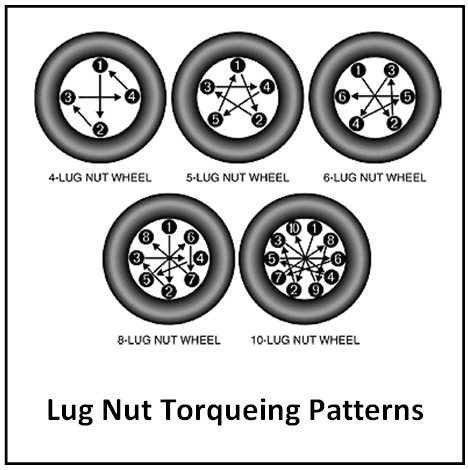 New studding methods have emerged, which include an eco-friendly anchor stud with an enlarged flange and a soft rubber compound at the base - so they are well cushioned and gentle on the road surface.
New studding methods have emerged, which include an eco-friendly anchor stud with an enlarged flange and a soft rubber compound at the base - so they are well cushioned and gentle on the road surface.
Modern tires use lightweight studs. They weigh only 0.7 grams, but have a rectangular carbide insert - they provide a minimum braking distance and the best car acceleration dynamics. But the main technological difference is the landing on glue. Thanks to this technology, the “glued” spikes keep perfectly in place and their loss has decreased by 2 times! nine0003
After purchase, studded tires are "run in". It implies smooth starting and braking, as well as low speed (60-80 km / h) for the first 200-300 km of run. Also, it is worth checking the pressure in the tires of the car more often. This will prevent premature wear of the spikes and their falling out.
Studs consist of two parts: body and carbide insert. The task of the body is to keep the stud in the tread body during the entire life of the tire. And the pin (carbide insert) should bite into the road surface, increasing the coefficient of adhesion on slippery surfaces. nine0003
The task of the body is to keep the stud in the tread body during the entire life of the tire. And the pin (carbide insert) should bite into the road surface, increasing the coefficient of adhesion on slippery surfaces. nine0003
Inserts are made of tungsten carbide and a number of compounds. Which are not reported: each manufacturer has its own proprietary recipe for hard alloy. But it is known that some additives make it possible to achieve a hardness of 1500 Vickers units. It is clear that such strength is not needed to work on ice or snow, but on asphalt, the carbide insert wears out with the same intensity as the tire tread.
In the pursuit of safety, not only cars, but also trucks were changed into studded tires. And then the road workers sounded the alarm, at the end of the winter season there were ruts on the asphalt, the spikes worked like a milling cutter. Therefore, according to the Technical Regulations of the Customs Union, for tires manufactured after January 1, 2016, the protrusion of the studs should be 1.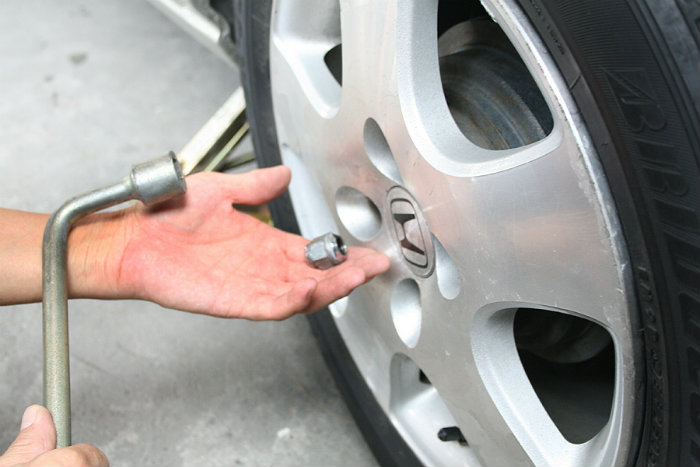 2 mm ± 0.3 mm. nine0051
2 mm ± 0.3 mm. nine0051
The stud bodies were originally made of steel. But as soon as the struggle for the preservation of the road surface unfolded and the mass of studs was limited, models with plastic cases appeared. The mass of the plastic stud assembled with the insert is only 0.7 grams, and the lightest steel studs weigh 1.1 grams. Unfortunately, the plastic sometimes does not withstand the load in combination with low temperatures and the studs fall out of the tread.
Almost all stud manufacturers have models with aluminum bodies. Alloyed aluminum is close to steel in strength, and in weight to plastic - its mass is 0.9grams. And coated with Teflon to facilitate mounting into the mounting hole and increase corrosion resistance.
By the way, corrosion complicates the shape of the case. At the base of a traditional stud there is only one flange, and salt, sand and water gradually penetrate into the gap between the body and the rubber, and a detrimental corrosion process begins. To put a barrier in the way of an aggressive environment, two or even three flanges are made on the body of the spikes. In addition, the multi-flange studs stay in place more firmly. But they have a drawback - they are more difficult to manufacture. nine0003
To put a barrier in the way of an aggressive environment, two or even three flanges are made on the body of the spikes. In addition, the multi-flange studs stay in place more firmly. But they have a drawback - they are more difficult to manufacture. nine0003
The studded rubber tread consists of two layers: the surface, softer one, is responsible for traction, and the inner hard layer holds the studs inserted into the holes of a special profile. In addition, a special soft rubber pad is provided under each stud so that when driving on a hard surface, the stud sinks inward, damaging the road less and increasing riding comfort.
Another factor in traction is the number of studs in the tire. In order not to destroy the roads, manufacturers were forced to reduce the number of spikes or make sure that they do not have a detrimental effect on the asphalt. New studding methods have emerged, which include an eco-friendly anchor stud with an enlarged flange and a soft rubber compound at the base of the stud - so they are well cushioned and gentle on the road surface.